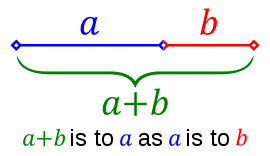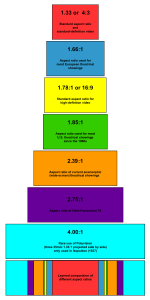Common Aspect ratio’s
by bram
in Video:
1.33:1 or 4:3 (“Four-Three”, “Four-by-Three”, or “Four-to-Three”)
1.78:1 or 16:9 (“Sixteen-Nine”, “Sixteen-by-Nine” or “Sixteen-to-Nine”)
1.60:1 or 16:10 (Widescreen computer monitor, such 1920×1200 resolution, renowned to be close to the aesthetically pleasing golden ratio (1.618)
in Film:
1.33:1 or 4:3 (silent films)
1.85:1 (“flat”,, introduced in May, 1953)
2.35:1 (“Scope”), The common anamorphic widescreen film format in use today.
2.39:1 (“two-four-oh”), named as (rounded) 2.40:1 or 2.40
Full list from wikipedia:
- 1.15
- Sometimes referred to as the Movietone ratio, this ratio was used briefly during the transitional period when the film industry was converting to sound, from 1926-32 approx. It is produced by superimposing an optical soundtrack over a full-gate 1.33 aperture in printing, resulting in an almost square image. Films shot in this ratio are often projected or transferred to video incorrectly using a 1.37 mask. Examples of films shot in the Movietone ratio include Sunrise, M and Hallelujah!.[9]
- 1.33 (4:3)
- 35 mm original silent film ratio, commonly known in TV and video as 4:3. Also standard ratio for MPEG-2 video compression. This format is still used in many personal video cameras today and has influenced the selection or design of other aspect ratios. It is the standard 16 mm and Super 35mm ratio.
- 1.37
- 35 mm full-screen sound film image, nearly universal in movies between 1932 and 1953. Officially adopted as the Academy ratio in 1932 by AMPAS. Rarely used in theatrical context nowadays, but occasionally used for other context.
- 1.43
- IMAX format. Imax productions use 70 mm wide film (the same as used for 70 mm feature films), but the film runs through the camera and projector sideways. This allows for a physically larger area for each image.
- 1.50 (3:2)
- The aspect ratio of 35 mm film used for still photography when 8 perforations are exposed. Also the native aspect ratio of VistaVision.
- 1.56 (14:9)
- Widescreen aspect ratio sometimes used in shooting commercials etc. as a compromise format between 4:3 (12:9) and 16:9. When converted to a 16:9 frame, there is slight pillarboxing, while conversion to 4:3 creates slight letterboxing.
- 1.60 (16:10)
- Widescreen computer monitor ratio (for instance 1920×1200 resolution).
- 1.66 (15:9 = 5:3)
- 35 mm Originally a flat ratio invented by Paramount Pictures, now a standard among several European countries; native Super 16 mm frame ratio. Sometimes this ratio is expressed more accurately as 1.67.
- 1.75
- Early 35 mm widescreen ratio, primarily used by MGM and Warner Bros. between 1953 and 1955, and since abandoned.
- 1.78 (16:9 = 42:32)
- Video widescreen standard, used in high-definition television, one of three ratios specified for MPEG-2 video compression. Also used increasingly in personal video cameras.
- 1.85
- 35 mm US and UK widescreen standard for theatrical film. Introduced by Universal Pictures in May, 1953. Projects approximately 3 perforations (“perfs”) of image space per 4 perf frame; films can be shot in 3-perf to save cost of film stock.
- 2.00
- Original SuperScope ratio, also used in Univisium. Used as a flat ratio for some American studios in the 1950s, abandoned in the 1960s, but recently popularized by the Red One camera system.
- 2.20
- 70 mm standard. Originally developed for Todd-AO in the 1950s.
- 2.21
- Specified in MPEG-2 for 2.20:1 movies, but hardly used.
- 2.35
- 35 mm anamorphic prior to 1970, used by CinemaScope (“‘Scope”) and early Panavision. The anamorphic standard has subtly changed so that modern anamorphic productions are actually 2.39,[1] but often referred to as 2.35 anyway, due to old convention. (Note that anamorphic refers to the compression of the image on film to maximize an area slightly taller than standard 4-perf Academy aperture, but presents the widest of aspect ratios.)
- 2.37 (64:27 = 43:33)
- As of 2010, TVs have been introduced with this aspect ratio and are marketed as “21:9 cinema displays”. This aspect ratio is not recognized by storage and transmission standards.
- 2.39
- 35 mm anamorphic from 1970 onwards. 2.39:1 is sometimes rounded up to 2.40:1[1]. Often commercially branded as Panavision format or ‘Scope.
- 2.55
- Original aspect ratio of CinemaScope before optical sound was added to the film in 1954. This was also the aspect ratio of CinemaScope 55.
- 2.59
- Cinerama at full height (three specially captured 35 mm images projected side-by-side into one composite widescreen image).
- 2.66
- Full frame output from Super 16 mm negative when an anamorphic lens system has been used. Effectively, an image that is of the ratio 2.66:1 is squashed onto the native 15:9 aspect ratio of a Super 16 mm negative.
- 2.76
- MGM Camera 65 (65 mm with 1.25x anamorphic squeeze). Used only on a handful of films between 1956 and 1964, such as Ben-Hur (1959).
- 4.00 (4:1 = 4×3:3)
- Rare use of Polyvision, three 35 mm 1.33 (4:3) images projected side by side. First used in 1927 on Abel Gance’s Napoléon.

